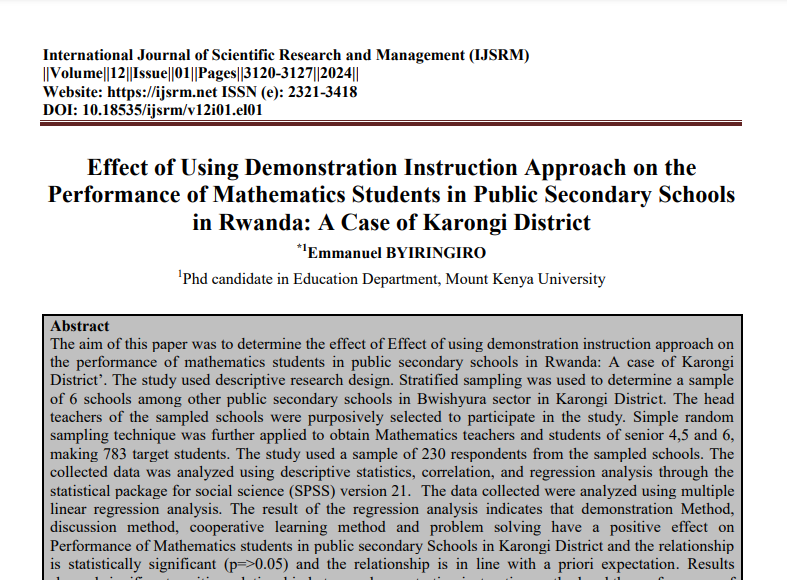Effect of Using Demonstration Instruction Approach on the Performance of Mathematics Students in Public Secondary Schools in Rwanda: A Case of Karongi District

Submission to VIJ 2024-01-02
Keywords
- demonstration approach, performance, mathematics, and students
Copyright (c) 2024 Emmanuel BYIRINGIRO

This work is licensed under a Creative Commons Attribution 4.0 International License.
Abstract
The aim of this paper was to determine the effect of Effect of using demonstration instruction approach on the performance of mathematics students in public secondary schools in Rwanda: A case of Karongi District’.The study used descriptive research design. Stratified sampling was used to determine a sample of 6 schools among other public secondary schools in Bwishyura sector in Karongi District. The head teachers of the sampled schools were purposively selected to participate in the study. Simple random sampling technique was further applied to obtain Mathematics teachers and students of senior 4,5 and 6, making 783 target students. The study used a sample of 230 respondents from the sampled schools. The collected data was analyzed using descriptive statistics, correlation, and regression analysis through the statistical package for social science (SPSS) version 21.The data collected were analyzed using multiple linear regression analysis. The result of the regression analysis indicates that demonstration Method, discussion method, cooperative learning method and problem solving have a positive effect on Performance of Mathematics students in public secondary Schools in Karongi District and the relationship is statistically significant (p=>0.05) and the relationship is in line with a priori expectation. Results showed significant positive relationship between demonstration instruction method and the performance of Mathematics students (r = .669, p = .0000). Multiple linear regression analysis showed that all demonstration instruction method contributed to 73% of variation on the performance, hence plays a vital role in performance of Mathematics students in public secondary schools in Karongi District. This study recommended that Mathematics teachers should use the demonstration instruction approach teaching Mathematics since it improves academic achievement.
References
- Biotenbeck, J. C. (2011). Teaching Practices and Student Achievement: Evidence from TIMSS. Madrid.
- Bligh, D. A. (2019). What’s the use of lectures? San Francisco: Jossey-Bass Publishers.
- Eniayeju, A. A. & Azuka, B. F. (2010). Impediments to mathematics teaching at the universal basic education level in Nigeria. Journal of Mathematical Sciences Education. 1(1)54-71.
- Mkumbo, K. A. K, (2013). An investigation into the Relationship Between School Characteristicsand Academic in Performance in Tanzania. Dar es Salaam.
- Karande, M. (2015). Poor School Performance, Indian Journal of Pediatrics, 72 (11), 961-967
- Olaitan, O. A. and Ogundoyin, I. K. (2015). Virtualization: A Sustainable Resource Management Strategy in Computing Practices. IOSR Journal of Computer Engineering 17(2):67-70.
- Cobb, H. (2018). The classroom social environment and changes in adolescents’ motivation and engagement during middle school. American Educational Research Journal, 38(2):437-460
- Ray, E. (Nov 2001) Discovering mathematics, the challenges that deaf /hearing impaired children encounter. ACE papers issues II
- Smith, A. (2014). Making Mathematics Count: The Report of Inquiry into Post Mathematics Education in the United Kingdom. London: Department of Education
- McCabe, J. A. (2014) Learning and memory strategy demonstrations for the psychology classroom. Baltimore: Goucher College.
- Muharam et al. (2005). Mathematics and deaf children: an exploration of barriers to success. Deafness & Education International, 7(1), 1-21.
- Tabulawa, R. (2016). International aid agencies, learner centred pedagogy and political democratization: A critique Comparative Education, 39(11), 7-26.
- Terezinhia, N. (2011) How to teach deaf children and others weak in mathematics oxford university.U.K.
- Zalmon, G. & Wonu, T. (2013). Role-play as a pedagogical method to prepare students for practice: The student’s voice, 3(3), 199-210
- Yee, F. P. (1987). Anxiety and Mathematics Performance in Female Secondary School Students in Singapore. Asia Pacific Journal of Education, 8(2):22-31
- Yamane, T. (1973) Statistics: An Introductory Analysis. 3rd Edition, Harper and Row, New York.